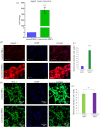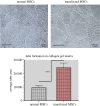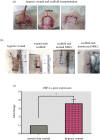Potential of stem cell seeded three-dimensional scaffold for regeneration of full-thickness skin wounds
- PMID: 35996740
- PMCID: PMC9372646
- DOI: 10.1098/rsfs.2022.0017
Potential of stem cell seeded three-dimensional scaffold for regeneration of full-thickness skin wounds
Abstract
Hypoxic wounds are tough to heal and are associated with chronicity, causing major healthcare burden. Available treatment options offer only limited success for accelerated and scarless healing. Traditional skin substitutes are widely used to improve wound healing, however, they lack proper vascularization. Mesenchymal stem cells (MSCs) offer improved wound healing; however, their poor retention, survival and adherence at the wound site negatively affect their therapeutic potential. The aim of this study is to enhance skin regeneration in a rat model of full-thickness dermal wound by transplanting genetically modified MSCs seeded on a three-dimensional collagen scaffold. Rat bone marrow MSCs were efficiently incorporated in the acellular collagen scaffold. Skin tissues with transplanted subcutaneous scaffolds were histologically analysed, while angiogenesis was assessed both at gene and protein levels. Our findings demonstrated that three-dimensional collagen scaffolds play a potential role in the survival and adherence of stem cells at the wound site, while modification of MSCs with jagged one gene provides a conducive environment for wound regeneration with improved proliferation, reduced inflammation and enhanced vasculogenesis. The results of this study represent an advanced targeted approach having the potential to be translated in clinical settings for targeted personalized therapy.
Keywords: biomaterials; hypoxia; mesenchymal stem cells; tissue engineering; transfection; wound regeneration.
© 2022 The Author(s).
Figures







References
Grants and funding
LinkOut - more resources
Full Text Sources
Research Materials
